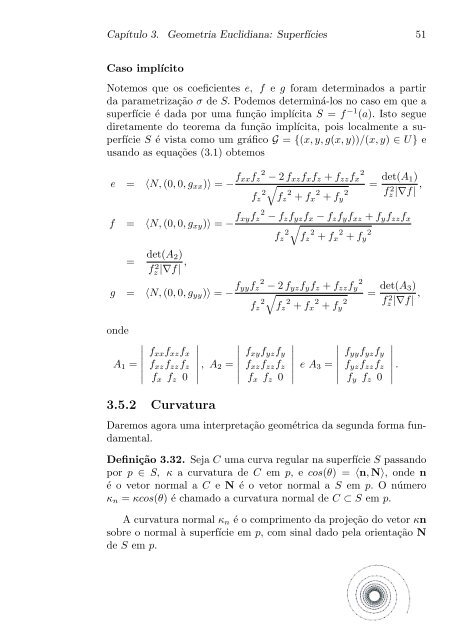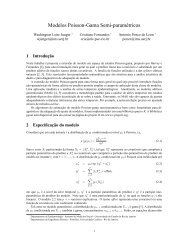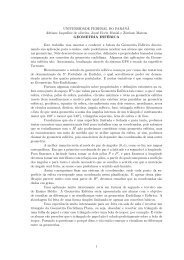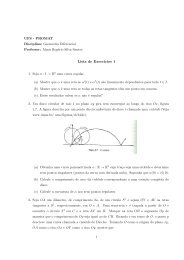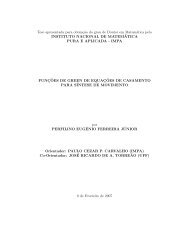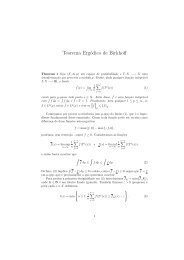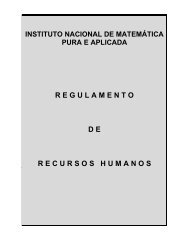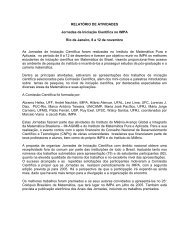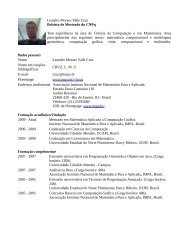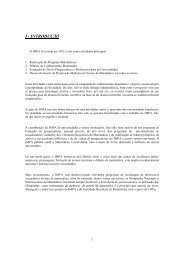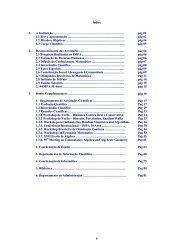Cálculo e Estimação de Invariantes Geométricos: Uma ... - Impa
Cálculo e Estimação de Invariantes Geométricos: Uma ... - Impa
Cálculo e Estimação de Invariantes Geométricos: Uma ... - Impa
- TAGS
- invariantes
- impa
- www.impa.br
Create successful ePaper yourself
Turn your PDF publications into a flip-book with our unique Google optimized e-Paper software.
Capítulo 3. Geometria Euclidiana: Superfícies 51<br />
Caso implícito<br />
Notemos que os coeficientes e, f e g foram <strong>de</strong>terminados a partir<br />
da parametrização σ <strong>de</strong> S. Po<strong>de</strong>mos <strong>de</strong>terminá-los no caso em que a<br />
superfície é dada por uma função implícita S = f −1 (a). Isto segue<br />
diretamente do teorema da função implícita, pois localmente a superfície<br />
S é vista como um gráfico G = {(x, y, g(x, y))/(x, y) ∈ U} e<br />
usando as equações (3.1) obtemos<br />
e = 〈N, (0, 0, gxx)〉 = − fxxfz 2 − 2 fxzfxfz + fzzfx 2<br />
�<br />
fz 2<br />
fz 2 + fx 2 + fy 2<br />
= <strong>de</strong>t(A1)<br />
f 2 z |∇f| ,<br />
f = 〈N, (0, 0, gxy)〉 = − fxyfz 2 − fzfyzfx − fzfyfxz + fyfzzfx<br />
�<br />
= <strong>de</strong>t(A2)<br />
f 2 z |∇f| ,<br />
fz 2<br />
fz 2 + fx 2 + fy 2<br />
g = 〈N, (0, 0, gyy)〉 = − fyyfz 2 − 2 fyzfyfz + fzzfy 2<br />
�<br />
on<strong>de</strong><br />
�<br />
�<br />
�<br />
A1 = �<br />
�<br />
�<br />
fxxfxzfx<br />
fxzfzzfz<br />
fx fz 0<br />
3.5.2 Curvatura<br />
�<br />
�<br />
�<br />
�<br />
�<br />
� , A2<br />
�<br />
�<br />
�<br />
= �<br />
�<br />
�<br />
fz 2<br />
fxyfyzfy<br />
fxzfzzfz<br />
fx fz 0<br />
fz 2 + fx 2 + fy 2<br />
�<br />
�<br />
�<br />
�<br />
�<br />
� e A3<br />
�<br />
�<br />
�<br />
= �<br />
�<br />
�<br />
fyyfyzfy<br />
fyzfzzfz<br />
fy fz 0<br />
= <strong>de</strong>t(A3)<br />
f 2 z |∇f| ,<br />
Daremos agora uma interpretação geométrica da segunda forma fundamental.<br />
Definição 3.32. Seja C uma curva regular na superfície S passando<br />
por p ∈ S, κ a curvatura <strong>de</strong> C em p, e cos(θ) = 〈n, N〉, on<strong>de</strong> n<br />
é o vetor normal a C e N é o vetor normal a S em p. O número<br />
κn = κcos(θ) é chamado a curvatura normal <strong>de</strong> C ⊂ S em p.<br />
A curvatura normal κn é o comprimento da projeção do vetor κn<br />
sobre o normal à superfície em p, com sinal dado pela orientação N<br />
<strong>de</strong> S em p.<br />
�<br />
�<br />
�<br />
�<br />
�<br />
� .


